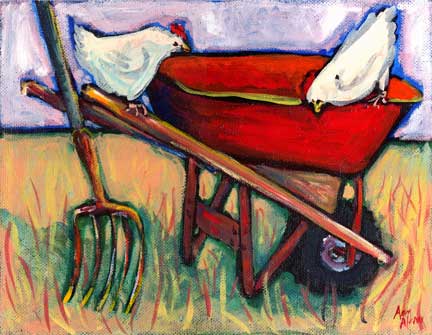William Carlos Williams, 1883 - 1963
so much depends
upon
a red wheel
barrow
glazed with rain
water
beside the white
chickens.
After reading this poem, it's hard to see a red wheelbarrow or hear the words "red wheelbarrow" without thinking of William Carlos William. He uses minimal words to get his message across. Williams, being an Imagist, includes a vivid imagery in his writing. An important detail in his imagery is the colors of the objects he describes. He writes of the “red” wheelbarrow, the “white” chickens, and rain water, which is usually defined as being blue.
Language in 'The Red Wheelbarrow'
The most famous poem by Williams is called 'The Red Wheelbarrow.' He wrote it one day after seeing a red wheelbarrow and white chickens in the backyard of an old, poor man who had worked hard his whole life.
he first thing you might notice about this poem is that it doesn't have any long words. Because Williams was writing about an everyday scene, he used everyday language. The lines sound like Williams might have said them to a buddy if they were just standing around observing the scene in the yard.
Again, this is an example of Williams using simplified language. Think about the description in the poem: it's of something ordinary, a red wheelbarrow in a backyard, and Williams is trying to show how even something normal like that can be special. The language he uses is just like the scene he describes: both ordinary and important.
Williams was part of a subset of modernism called imagism. Imagist writers believed that describing images was even more important than talking about big philosophical ideas. In Williams' own words, imagists believed that there are 'no ideas but in things.' In other words, the images a poet uses are what give meaning to the poem.
As a poem, 'The Red Wheelbarrow' reflects these ideas of imagism. Its focus is almost entirely on a simple, bare description of a tableau, or scene. The only part of the poem that isn't a part of this description is the first two lines, 'so much depends/upon.'
If you're wondering why you should care about a poem that's just about a red wheelbarrow, these two lines offer you a reason: it's not just about a red wheelbarrow - it's about something else. And with these opening lines, Williams issues a challenge to his readers. He dares them to figure out what else the poem is about.
There are lots of theories. Some people believe that Williams is commenting on the functionality of the wheelbarrow - the way it allows people to move things from one place to another easily. Others think it has to do with things seeming fresh and glowing after a literal or figurative storm. Still others believe that it's about how hard the old man who owned the wheelbarrow worked during his life.
How can so many people disagree on what the poem is about? That's because Williams leaves it vague. Whether you agree with one of the above interpretations or whether you have your own idea of why 'so much depends upon' that red wheelbarrow, the point is that Williams doesn't make his poem clear. He's issuing a challenge to his readers: 'You figure out why the red wheelbarrow is important, because I'm not going to tell you!'
This attitude became very common in poetry; even almost a century after Williams wrote 'The Red Wheelbarrow,' poets still use this type of writing. Poems today are often deliberately left vague and open to interpretation. So if you find it hard to understand what poets are talking about, you can thank William Carlos Williams for making readers think!

No comments:
Post a Comment